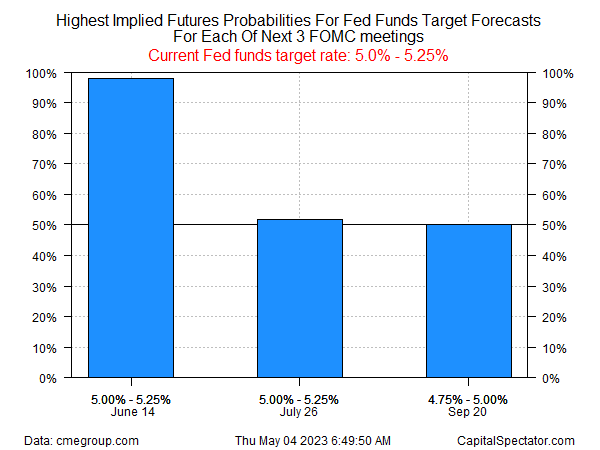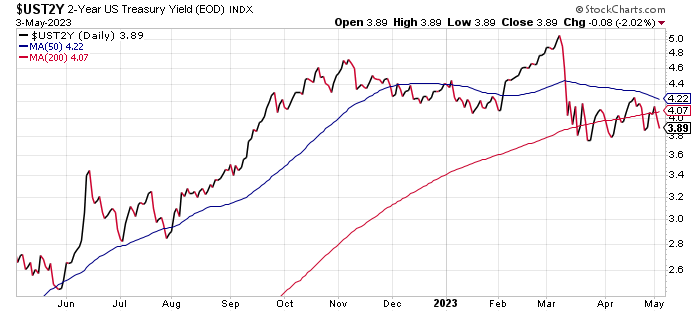The Federal Reserve raised interest rates for a 10th straight time on Wednesday, lifting its target by a 1/4-point to a 5.0%-to-5.25% range, the highest since 2007. But there are hints that the central bank may be set to pause at the next policy meeting in June and start cutting later in the year. Much depends on how the economic and inflation data compare in the updates during the weeks and months ahead. But for now, the crowd thinks the rate-hiking cycle may have peaked.
Consider the outlook via Fed funds futures this morning. A pause is currently priced in as a near certainty at the June 14 meeting , based on CME data. Another pause and a cut are expected to be the most likely scenarios at the two FOMC meetings that follow, although in those cases the implied probabilities are roughly a coin toss at this point.

The two-year Treasury yield, considered the most policy-sensitive rate, continues to trade well below the Fed funds rate, offering another market-based forecast that the central bank will soon pause and then cut.

Officially, the Fed is taking a wait-and-see position. Answering a question at yesterday’s press conference on whether the policy statement indicates a pause is likely at the June FOMC meeting, Fed Chair Jerome Powell said: “That’s a meaningful change that we’re no longer saying that we ‘anticipate’. So we’ll be driven by incoming data, meeting by meeting, and we’ll approach that question at the June meeting.”
The critical factor, of course, is how inflation compares going forward. Although pricing pressure has eased, the decline has been modest lately and the current level of inflation — at 4.2%, based on the personal consumption expenditures index — remains well above the Fed’s 2% target.
“It’s not like inflation is going to suddenly start cooling,” says Julia Coronado, the president and founder of MacroPolicy Perspectives. “But the economy will be cooling and the banking distress will remain front and center, and that will add to the credit tightening the economy has to absorb.” Those factors imply that the odds are rising for a pause and then a cut.
Nonetheless, Powell reminded: “Inflation pressures continue to run high, and the process of getting getting inflation back down to 2% has a long way to go.”
Andy West, co-founder of Longlead Capital Partners & HedgQuarters, sees the potential for a hawkish surprise. “The Fed removed the ‘ongoing’ hike language but left open the possibility of rate fine tuning,” he tweets. “As financial conditions loosen (a risk that rises on a pause), core inflation has shown a tendency to bounce.” He advises that “the market is already pricing no further hikes and a move to cuts. I raise the possibility we have a 1-month pause, followed by another 25bps [hike] later that surprises everyone.”
The next key data point that may change the calculus: tomorrow’s payrolls report for April. The Labor Dept. is expected to announce that hiring slowed to a 178,000 increase, down substantially from March’s 236,000 gain, based on the Econoday.com’s consensus forecast. If correct, the prospects for a pause will strengthen.
How is recession risk evolving? Monitor the outlook with a subscription to:
The US Business Cycle Risk Report